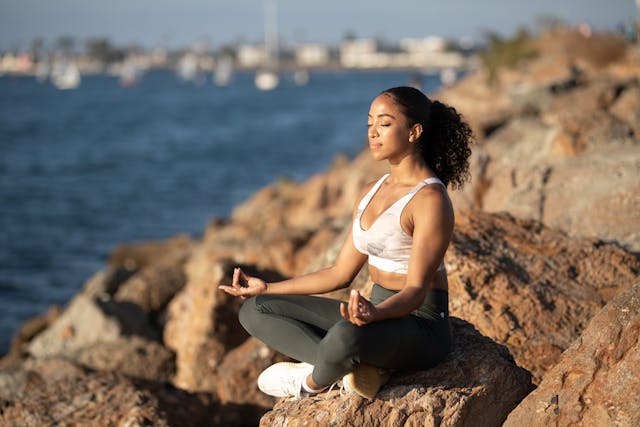
Finding moments of peace and clarity can seem elusive in today’s fast-paced world, where distractions abound and demands constantly tug at our attention. Yet, amidst the hustle and bustle of daily life, there lies a practice that offers a pathway to inner calm and presence: mindfulness. Rooted in ancient contemplative traditions and now supported by modern scientific research, mindfulness has emerged as a powerful tool for enhancing mental well-being and overall quality of life.
At its core, mindfulness is about being fully present in the moment, without judgment or attachment to the past or future. It invites us to cultivate a heightened awareness of our thoughts, emotions, and sensations, fostering a deep connection with ourselves and the world around us. While the concept may seem simple, its practice can be profoundly transformative, offering a sanctuary of stillness amid life’s storms.
In this exploration of mindfulness, we delve into practical techniques that anyone, especially beginners, can integrate into their daily lives. These exercises are not merely theoretical concepts but actionable steps that empower individuals to nurture mindfulness as a daily habit. Whether you seek to reduce stress, improve focus, or simply experience a greater sense of inner peace, these practices offer a gentle yet potent way to cultivate mindfulness in every moment.
Join us on this journey as we uncover five daily mindfulness exercises designed to awaken your awareness, deepen your connection with yourself and others, and illuminate the path to a more mindful existence. Through these practices, may you discover the profound benefits of mindfulness and embark on a transformative journey towards a more present and fulfilling life.
1. Mindful Breathing (Anapanasati)
Mindful breathing is one of the fundamental practices in mindfulness meditation. It involves focusing your attention on the natural rhythm of your breath. Here’s how you can practice it:
- Find a comfortable seated position or lie down with your eyes closed.
- Take a few deep breaths to settle into the present moment.
- Focus your attention on the sensation of your breath as it enters and leaves your nostrils or the rise and fall of your abdomen.
- Notice the sensations without trying to control your breath.
- When your mind wanders (which is natural), gently bring your focus back to your breath.
For a deeper understanding of mindfulness meditation, you can explore Jon Kabat-Zinn’s book, “Wherever You Go, There You Are: Mindfulness Meditation in Everyday Life” which explores various mindfulness practices including mindful breathing.
2. Body Scan Meditation
Body scan meditation involves systematically focusing on different parts of your body, from head to toe, bringing awareness to physical sensations, tension, or areas of relaxation. This practice helps in developing body awareness and can be done lying down or sitting comfortably.
- Start by bringing your attention to the top of your head. Notice any sensations, tension, or warmth.
- Slowly move your focus down through your body, part by part, noticing sensations in each area without judgment.
- If you encounter areas of tension, breathe into those areas and consciously relax them.
- This practice helps in grounding yourself in the present moment and becoming more attuned to your body’s signals.
For guided body scan meditations, you can refer to Headspace or Insight Timer apps, which offer guided sessions suitable for beginners.
3. Mindful Walking
Mindful walking is a practice of bringing mindfulness into motion. It involves paying attention to each step and the sensations of walking, rather than letting your mind wander. You can practice mindful walking indoors or outdoors, at a pace that feels comfortable.
- Begin by standing still and bringing your awareness to the soles of your feet.
- As you start walking, feel the sensations of lifting your foot, moving it forward, and placing it back down.
- Notice the rhythm of your steps, the movement of your body, and the sounds around you.
- If your mind starts to wander, gently guide your attention back to the physical sensations of walking.
Thich Nhat Hanh, a renowned Buddhist monk and author, often writes about mindfulness in everyday activities, including walking meditations, in his book “Peace Is Every Step: The Path of Mindfulness in Everyday Life”.
4. Mindful Eating
Mindful eating involves bringing awareness to the experience of eating, from the flavors and textures of food to the sensations of chewing and swallowing. This practice enhances your connection to food and promotes healthier eating habits.
- Before you eat, take a moment to appreciate the appearance and aroma of your food.
- As you take your first bite, notice the taste and texture. Chew slowly and savor each mouthful.
- Be aware of how your body feels as you eat. Notice feelings of hunger, satisfaction, or fullness.
- Avoid distractions like phones or screens, and focus solely on the act of eating and enjoying your meal.
Dr. Jan Chozen Bays, in her book “Mindful Eating: A Guide to Rediscovering a Healthy and Joyful Relationship with Food”, explores how mindfulness can transform your relationship with food and eating habits.
5. Gratitude Practice
A gratitude practice involves intentionally focusing on things you are grateful for, which cultivates a positive mindset and enhances overall well-being. It’s a simple yet powerful way to bring mindfulness into your daily life.
- Set aside a few minutes each day to reflect on things you’re grateful for, whether big or small.
- Write them down in a gratitude journal or simply contemplate them in your mind.
- Notice how expressing gratitude makes you feel—appreciative, joyful, or content.
- Over time, this practice trains your mind to notice the positive aspects of life, even during challenging times.
Robert Emmons, a leading gratitude researcher, discusses the transformative power of gratitude in his book “Thanks!: How the New Science of Gratitude Can Make You Happier”.
Conclusion
Incorporating these mindfulness exercises into your daily routine can significantly enhance your overall well-being, reduce stress, and improve your ability to stay present in each moment. Whether you choose to start with mindful breathing, body scan meditations, or practicing gratitude, the key is consistency and gentle persistence. By nurturing mindfulness in your daily life, you empower yourself to live more fully and consciously.
Remember, mindfulness is a journey, not a destination. As you continue to explore and practice these exercises, you’ll discover their transformative potential in fostering a deeper sense of peace and connection within yourself and the world around you.








